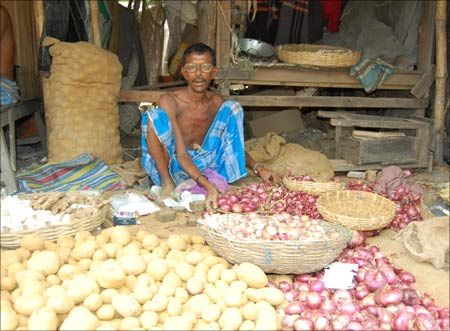
Onions had the highest inflation rate among all major commodities.
Dropping of general wholesale prices in October for a 12th straight month in October masked the fact that some food items -- pulses, particularly tur (pigeon pea) and onions -- have seen a surge in inflation since November last year.
The downward spiral in the Wholesale Price Index has been characterised by ebbing global commodity prices and equally weak domestic demand.
In this scenario, high inflation rates for food articles like pulses, having 0.72 per cent weightage in the index, and onions (0.18 per cent weightage) were caused by supply-side problems.
Onions had the highest inflation rate among all major commodities.
In October alone, it rose 85.7 per cent over a year ago.
However, WPI inflation in onions was coming down in recent months, though it has been at an elevated level since February when it first jumped up, by about 26 per cent.
Devendra Pant, chief economist at India Ratings & Research, says, "Onion production has progressively fallen in the country. Yet, timely intervention from the government could have ceased the rise."
Bulk import, he felt, was possibly the only solution in the near future, especially as global commodity prices continue to be low.
Pulses, which had the second highest inflation rate, has spiked by 51.5 per cent since November last year.
The October rise, of 53 per cent, was the highest monthly change in a decade.
Among pulses, the highest inflation rate was recorded for tur at 93.2 per cent, followed by urad (black gram) at 72.3 per cent and gram (53.9 per cent) in these 12 months.
Data from the department of consumer affairs suggest tur prices jumped 111 per cent in this period in the North. The least rise was in the West zone, but even this corresponded to a doubling of tur prices.
Urad rose the most in the South, by 93 per cent.
Aditi Nayar, senior economist at ICRA, said: "Measures to improve yields and acreage of pulses warrant a heightened focus."
The chronic imbalance between domestic demand and supply, combined with limited sources of imports, leads to recurrent spikes in the price, she said.
Also, gaps in distribution and infrastructure are a problem across agricultural segments.
This has led to other commodities, like tomatoes, displaying a high inflationary trend.
These have touched a record Rs 2,540 a quintal in the East zone.
On the other hand, potatoes fell by 59.2 per cent, the widest such margin, in the period.
Their price sunk to Rs 850 a quintal from the earlier Rs 2,125 in the East during this period.
Oilseeds, in the category of non-food article, were the next highest rising commodity, growing 7.5 per cent.
In the same category, minerals saw the second highest fall, dropping 32 per cent.
So far this financial year, global metals and mineral prices have fallen an average of 21.3 per cent over a year, say experts.
Manufactured products have a significant 65 per cent total weightage in the index and these fell 1.35 per cent. Pant says this was an example of a classic demand-side problem.
"Inflation slumped owing to sustained weakening in domestic demand conditions and equal softening in global commodity prices," he said.
The former disallowed an increase in market prices and the latter brought down input costs for Indian manufacturers.
This has created a supply glut.
Edible oils, wood and wood products were among the top five in rising commodities, each up 4.2 per cent.
Although the manufactured foods segment rose marginally by 0.98 cent, sugar fell 13.8 per cent in the past 12 months.
Sustained production surpluses over domestic consumption have led to progressively subdued prices in the past five years.
Shaky liquidity in the industry has resulted in huge cane payment arrears to farmers.
Also, regional variations remain large, with sugar prices going down by 19 per cent in the West, but by only five per cent in the North.
Among other manufactured products, iron and semi-finished casting products saw a major downward trend, falling 12.6 per cent.
Another area where prices remain depressed is fuel and power, with 15 per cent weightage in the WPI.
This went down by 11.5 per cent in the November-October period of 2014-15. In the current financial year, global fuel prices have slipped 45 per cent.
These ensured sectoral components such as petrol and cooking gas fell significantly, with high power diesel prices reducing by 18 per cent since last November.
IMAGE: A vegetable vendor in West Bengal. Photograph: Dipak Chakraborty/Rediff.com










